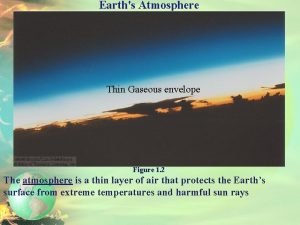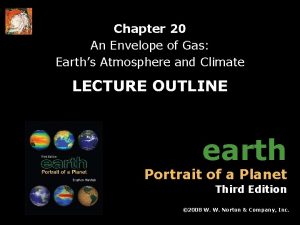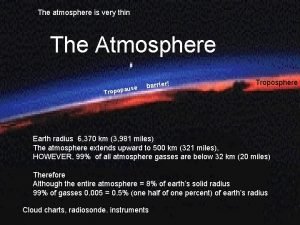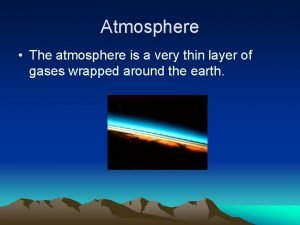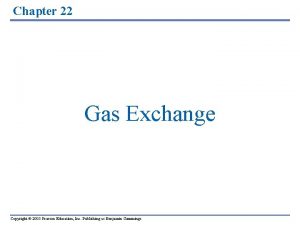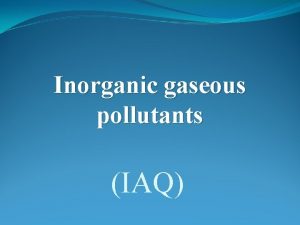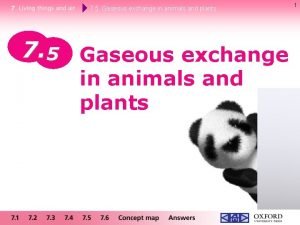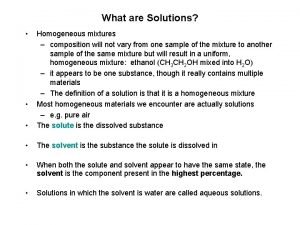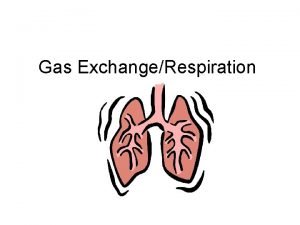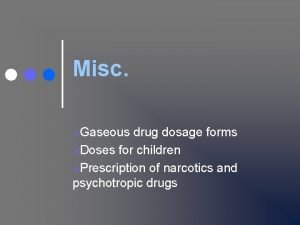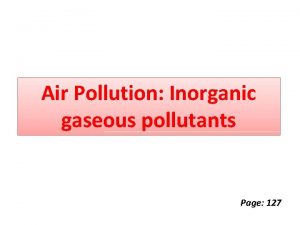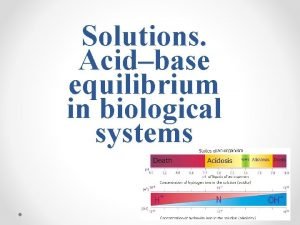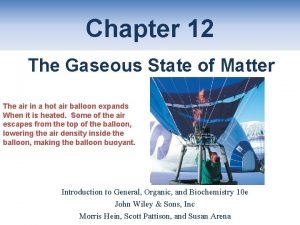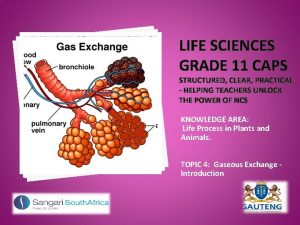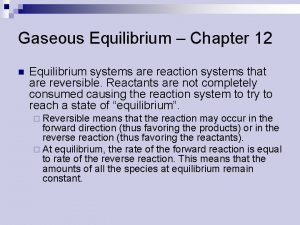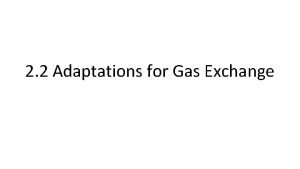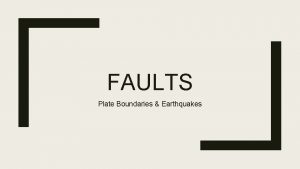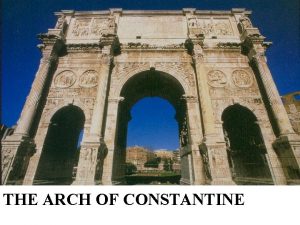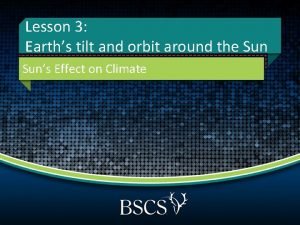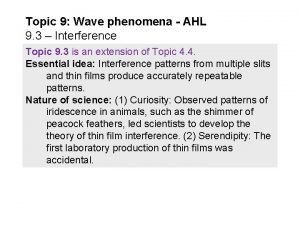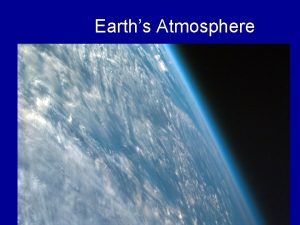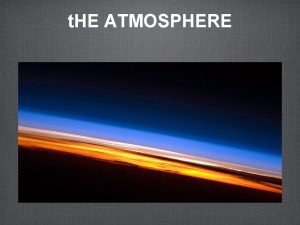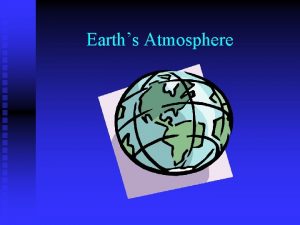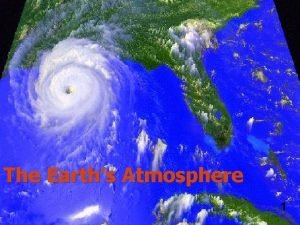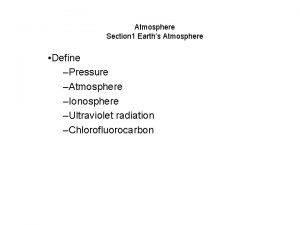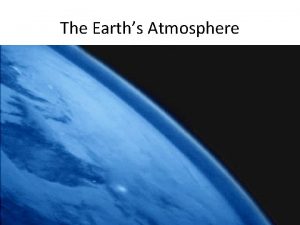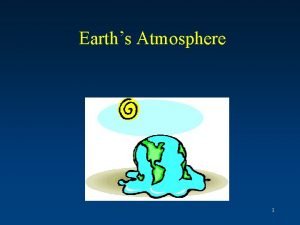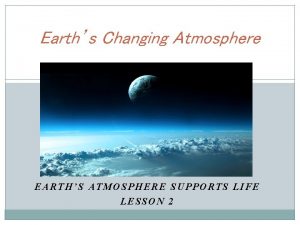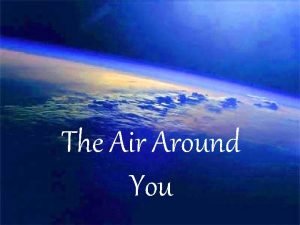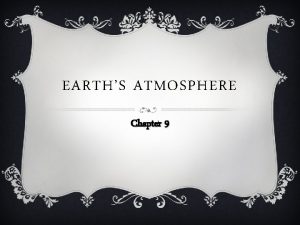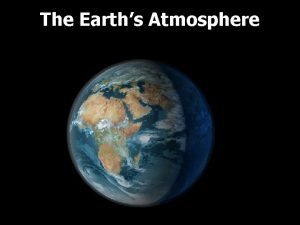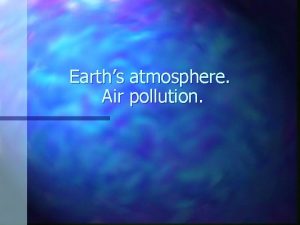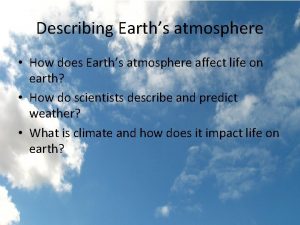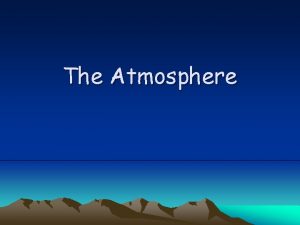Earths Atmosphere Thin Gaseous envelope Figure 1 2
















































- Slides: 48

Earth's Atmosphere Thin Gaseous envelope Figure 1. 2 The atmosphere is a thin layer of air that protects the Earth’s surface from extreme temperatures and harmful sun rays

Five Layers of the Atmosphere

Lower Layers of Atmosphere • Troposphere: lowest layer – extends up to 10 km; contains 99% of the water vapor and 75% of the atmospheric gases • The troposphere is the first layer above the surface and contains most clouds and half of the Earth's atmosphere. • Weather occurs in this layer. • Most of the layer’s heat is from Earth • Temperature cools about 6. 5 degrees Celsius per kilometer of altitude.

Lower Layers of Atmosphere • Stratosphere – directly above troposphere, extending from 10 km to about 50 km above Earth’s surface • Portion of the upper layer contains high levels of a gas called ozone • Many jet aircrafts fly in the stratosphere because it is very stable. Also, the ozone layer absorbs harmful rays from the Sun.

Upper Layers of Atmosphere • Mesosphere – extends from the top of the stratosphere to about 85 km above Earth • Coldest layer with little ozone • Meteors or rock fragments burn up in the mesosphere. • Ionosphere – layer of charged particles

Upper Layers of Atmosphere • Thermosphere – thickest atmospheric layer found between 85 km and 500 km above Earth’s surface • The thermosphere is a layer with auroras, known for its high temperatures. • Warms as it filters out X-rays and gamma rays from the Sun • Ionosphere, too – help carry radio waves.

Upper Layers of Atmosphere • Exosphere - The atmosphere merges into space in the extremely thin exosphere. This is the upper limit of our atmosphere. • Outer layer where space shuttle orbits.

Layers of Atmosphere

Composition of Atmosphere (Mixture of gases, solids, and liquids) • Early atmosphere was much different than today • Volcanoes produced nitrogen and carbon dioxide, but little oxygen (https: //www. youtube. com/watch? v=h 8 W_s. GYAQlc ) • More than 2 billion years ago, early organisms began producing oxygen • Eventually, oxygen formed an ozone layer that protected Earth from harmful rays • Green plants and diverse life forms developed

Atmospheric Gases (Mixture of gases, solids, and liquids) • Nitrogen - 78% • Oxygen - 21% • Water Vapor – 0 to 4% • Used for clouds and precipitation • Carbon Dioxide -. 037% • Keeps Earth warm and is used by plants to make food • Argon -. 93% • Traces of neon, helium, methane, krypton, xenon, hydrogen, and ozone

Atmospheric Gases (Mixture of gases, solids, and liquids) • Atmosphere is changing with the introduction of pollutants; evidence suggests that increasing human energy use is increasing the amount of carbon dioxide • Pollutants mix with oxygen and other chemicals to form smog (https: //www. youtube. com/watch? v=xgx. Ye-_xe. I 8 ) • Aerosols include solids such as dust, salt, and pollen • Liquids include water droplets and droplets from volcanoes

Atmospheric Pressure • Molecules closer to the surface are more densely packed (at higher pressure) together than those higher in the atmosphere because of the mass of gases pressing down on them from higher in the atmosphere (https: //www. youtube. com/watch? v=Qe. Ap 3 Cu. Gjk 8 )

Seasons on other Planets • https: //www. youtube. com/watch? v=Wr. HG 3 jg. SFCA • New You. Tube channel with space news

The Ozone Layer (https: //www. youtube. com/watch? v=Yxsxfs. Yx. A 4 s ) • About 19 km to 48 km above Earth in the stratosphere (90%) and mesosphere(10%). • Layer of 3 -atom molecules that protects the Earth from the Sun’s harmful ultraviolet radiation • Life depends on the ozone! • Pollutants called chlorofluorocarbons (CFCs) are destroying the ozone • CFCs were used in refrigerators, air conditioners, aerosol sprays, and foam packaging ~ if products leak, CFCs enter atmosphere • Ozone layers has a large hole over Antarctica and a smaller one over the North Pole (https: //www. youtube. com/watch? v=zr. SPhs. Fos. Rg )

• Some of the Sun’s energy coming through Earth’s atmosphere is reflected or absorbed by gases and/or clouds in the atmosphere.

Greenhouse Effect • Solar energy that is absorbed by the Earth’s land water is changed to heat that moves/radiates back into the atmosphere (troposphere) where gases absorb the heat, a process known as the greenhouse effect. https: //www. youtube. com/w atch? v=3 v-w 8 Cyfoq 8

Water Cycle – water makes up 70% of Earth’s surface!!

• Rain & Drizzle- most common type of precipitation. • Freezing Rain- drizzle from stratus clouds. • Freezing Rain- raindrops freeze when they hit the ground. • Sleet- raindrops that freeze before they hit the ground.

• snow- as ice grows and merges into clouds they form snowflakes. • hail- is the largest type of precipitation. • Lumps or balls of ice that fall from cumulonimbus clouds in warm weather.


Why do you think there is this band of clouds near the equator?

Did you figure it out? • Warm, moist air in the tropics rises • Cold air can hold less moisture than warm air • As the moist air rises, it condenses and forms clouds!

Humidity • The amount of water vapor in the air • Temperature affects how much moisture is in the air - warmer air can hold more water vapor, tending to make it more humid • Relative humidity – the amount of water vapor in the air compared to what it can hold at a specific temperature • When air cools, it can’t hold as much water vapor, so the water vapor condenses to liquid or forms ice crystals • Dew point – the temperature at which air is saturated and condensation forms

Clouds • Form when air rises, cools to its dew point, and becomes saturated • Shape and height of clouds vary with temperature, pressure, and water vapor in atmosphere

Clouds • Shape • Stratus-smooth, even sheets or layers at low altitudes • Cumulus-puffy, white clouds, often with flat bases • Cirrus-high, thin, white feathery clouds made of ice crystals • Height • Cirro – high clouds • Alto – middle-elevation clouds • Strato – low clouds • Nimbus clouds are dark and so full of water that sunlight can’t penetrate them

Clouds • LOW CLOUDS – form at 2, 000 m or less in altitude • Cumulus – puffy clouds formed when air currents rise and carry moisture • Stratus – layered dull, gray sheets that can cover the entire sky • Nimbostratus – low, dark, thick layers that hide the Sun

Cumulus · Clouds formed at medium or low elevation. · Cumulus clouds are puffy with flat bottoms. · When cumulus clouds are white they often signal fair weather, but when they are darker, they may signal rain or thunderstorms.

Stratus • Clouds formed at medium or low elevation; spread out layer upon layer covering a large area • As stratus clouds thicken, precipitation usually occurs over that area.

Cumulus

Stratus


Clouds • MIDDLE CLOUDS – form between 2, 000 m and 8, 000 m in altitude • Most are layered • Names have alto- prefix (altocumulus and altostratus) • Can produce light precipitation



Clouds • HIGH AND VERTICAL CLOUDS • Cirrus – wispy, high-level clouds • Cirrostratus – high, layered clouds that can cover the sky • Cumulonimbus – known as thunderstorm clouds; produce heavy precipitation

Cirrus • Clouds formed at high elevations; wispy clouds usually consisting of ice crystals that signal fair weather or may also signal an approaching warm front.

Cirrus





Fog


Blizzard • A winter storm with strong winds, cold temperatures, and low visibility, that lasts more than three hours

Tornado • Violent, whirling wind that moves in a narrow path over land

Hurricane • Large, swirling, low-pressure system that forms over tropical oceans • Heat energy from moist air is converted to wind that can reach speeds of 250 km/h

Severe Weather • Thunderstorms occur inside warm, moist air masses and at fronts • Warm, moist air is forced rapidly upward, where it cools and condenses • Strong updrafts of warm air and sinking, rain-cooled air cause strong winds

Lightning • Movement of air inside a storm cloud causes parts of the cloud to become oppositely charged • Current flows between the regions of opposite electrical charge, forming a lightning bolt • Thunder – lightning superheats the air, causing it to expand rapidly and then contract, forming sound waves
 Gaseous envelope of the sun
Gaseous envelope of the sun Earths early atmosphere contained
Earths early atmosphere contained The thin envelope of gases
The thin envelope of gases It has a very thin atmosphere 
It has a very thin atmosphere  Very thin layer
Very thin layer Pearson
Pearson Inorganic gases
Inorganic gases At 500 k one mole of gaseous oncl
At 500 k one mole of gaseous oncl Gaseous exchange in animals
Gaseous exchange in animals My very excited mother just
My very excited mother just Gas and liquid solution example
Gas and liquid solution example Carbaminohemoglobin
Carbaminohemoglobin Gaseous dosage form
Gaseous dosage form Inorganic gaseous pollutants of air
Inorganic gaseous pollutants of air Non gaseous alkalosis
Non gaseous alkalosis Gaseous state chapter
Gaseous state chapter Life science grade 11 gaseous exchange practical
Life science grade 11 gaseous exchange practical Gaseous equilibrium
Gaseous equilibrium Gaseous exchange in protozoa
Gaseous exchange in protozoa Classification of parenteral dosage form
Classification of parenteral dosage form Contraction porosity denture
Contraction porosity denture Whats a natural satellite
Whats a natural satellite Earths boundaries
Earths boundaries Earths crust
Earths crust Earths major crustal plates
Earths major crustal plates Whats earths moon called
Whats earths moon called Describe the true shape of earth's orbit
Describe the true shape of earth's orbit Honey as fertilizer for plants
Honey as fertilizer for plants Earths biomes
Earths biomes Where
Where Which layer of the earth slowly moves like putty
Which layer of the earth slowly moves like putty Earths orbit seasons
Earths orbit seasons The earth's layers foldable
The earth's layers foldable Earths 4 spheres
Earths 4 spheres The emperor constantine i recycled sculpture
The emperor constantine i recycled sculpture Whats the name of earths moon
Whats the name of earths moon Periodic table of elements families
Periodic table of elements families What does the earths tilt cause
What does the earths tilt cause Foldable layers of the earth
Foldable layers of the earth Brown earths
Brown earths Earths roation
Earths roation What does earths tilt do
What does earths tilt do Earths mantle
Earths mantle Plasticity in earth's layers
Plasticity in earth's layers Atmosphere definition science
Atmosphere definition science Study of the earth's physical features
Study of the earth's physical features Soap envelope structure
Soap envelope structure Carta de saudação
Carta de saudação Single slit envelope
Single slit envelope
